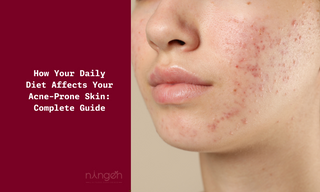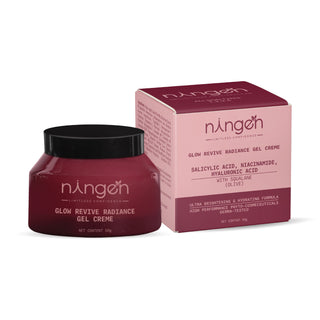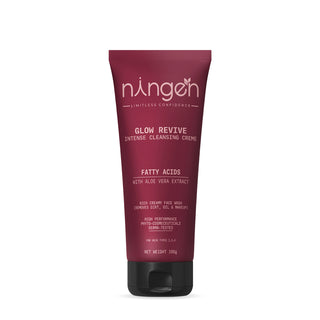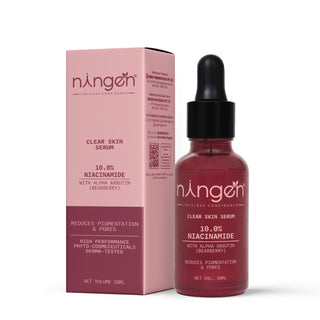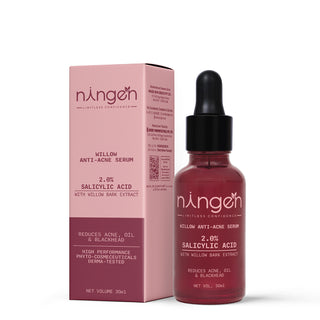TLDR: What you eat every day has a huge impact on how well your skincare routine works for acne-prone skin. Foods like white rice, dairy products, and processed snacks can make pimples worse, while foods rich in good fats, zinc, and antioxidants help your skin stay clear. When you combine the right eating habits with proper skincare, you can see up to 40% better results.
Why Your Daily Meals Matter More Than Your Face Wash?
Think about this for a moment - you spend thousands of rupees on fancy face washes, serums, and treatments from beauty stores. You religiously follow that skincare routine you saw on Instagram. But every morning, you still find new pimples staring back at you from the mirror. Does this sound like your story?
Here's something that might surprise you - your daily meals could be the real reason your skincare isn't working. Recent research from medical colleges has shown that when people change their eating habits and use their regular skincare products, their skin becomes 35-40% clearer compared to those who only use skincare products.
The shocking part? About 78% of people dealing with acne completely ignore what they eat. They focus only on what they put on their face, not what goes into their stomach. But your grandmother was right when she said "beauty comes from within" - she just didn't know the scientific reason behind it.
Are you ready to bid adieu to acne and pimples on your face or body? Check out this guide to learn how your diet affects your acne-prone skin.
In This Guide;
Common Foods That Could Be Ruining Your Skincare Routine
Foods That Actually Help Your Acne-Prone Skin
Common Mistakes That Kill Your Progress
Timing Your Meals for Maximum Benefits
Understanding How Food Affects Your Skin - The Simple Science
Let's break this down in simple terms. When you eat certain foods, your body reacts in ways that directly affect your skin. It's like a chain reaction that starts in your stomach and ends up on your face.
When you eat foods that spike your blood sugar quickly (like white bread, regular rice, or sugary drinks), your body produces more insulin. This insulin tells your skin to produce more oil. More oil means more chances for your pores to get blocked, leading to pimples. Similarly, when you drink milk or eat paneer, your body gets hormones that can confuse your skin cells and make them produce more oil and shed more dead skin cells.
The latest research (2024) has found that people with acne problems often have different bacteria in their stomachs compared to those with clear skin. They have 23% fewer good bacteria and more of the harmful types. This imbalance in stomach bacteria directly affects how your skin looks and heals.
Common Foods That Could Be Ruining Your Skincare Routine
White Rice and Refined Wheat Products
This is probably the hardest truth for most people to accept. Our daily staples - white rice, white bread, naan, and regular rotis made from refined wheat flour - can be major acne triggers. These foods cause your blood sugar to shoot up quickly, leading to insulin spikes that make your skin produce more oil.
Think about it - you might be eating rice twice a day, every day. That's like giving your skin an oil-production signal multiple times daily. The solution isn't to give up carbs completely, but to switch to better options like brown rice, quinoa, daliya (broken wheat), or rotis made from whole wheat flour. These release sugar slowly into your bloodstream, keeping your skin calmer.
Dairy Products - The Controversial Truth
This might be controversial, but multiple recent studies confirm that dairy products can worsen acne. This includes milk, paneer, cheese, curd, buttermilk, and even that protein-rich lassi you have post-workout. Interestingly, skim milk and low-fat dairy products are actually worse for acne than full-fat versions.
Priya, a 26-year-old software engineer, shared her experience: "I was drinking two glasses of milk daily and eating paneer regularly. When I stopped dairy for two months while continuing my same skincare routine, my cystic acne reduced by almost 60%."
The practical reality is that completely removing dairy from most diets is extremely difficult. The key is to reduce quantity and see how your skin responds. You might find that you can handle small amounts of curd but not milk, or vice versa.
Processed and Fried Foods
Our love affair with samosas, pakoras, biscuits, namkeens, and ready-to-eat snacks could be sabotaging our skin. These foods are loaded with refined oils, preservatives, and artificial ingredients that create inflammation throughout the body, including the skin.
Street food is often fried in oils that have been used multiple times. These degraded oils create free radicals in your body, which damage skin cells and slow down healing. Even seemingly healthy options like multigrain biscuits often contain hidden sugars and inflammatory oils.

Hidden Sugar Culprits
We often think we don't eat much sugar, but sugar hides in many foods. Regular ketchup, ready-made curry bases, flavored yogurt, packaged fruit juices, and restaurant preparations contain surprising amounts of sugar. That mango lassi you think is healthy? It often contains as much sugar as a soft drink.
Restaurant food is typically higher in salt, sugar, unhealthy oils, and preservatives compared to home-cooked meals. Even apparently healthy restaurant salads often come with sugary dressings or are prepared using ingredients that aren't skin-friendly.
Also read: 15 tips to prevent acne & pimples.
Foods That Actually Help Your Acne-Prone Skin
Traditional Spices and Healing Foods
Our ancestors knew what they were doing when they made turmeric, ginger, garlic, and other anti-inflammatory spices central to cooking. Turmeric contains curcumin, one of nature's most powerful anti-inflammatory compounds. When you consume it regularly (like in dal, sabzi, or haldi doodh), it helps reduce the inflammation that causes acne.
Fresh ginger helps improve digestion and reduces inflammation throughout the body. Garlic has natural antibacterial properties that can help fight acne-causing bacteria from the inside out. The key is using these spices fresh and in their natural form, not as processed powders.
Omega-3 Rich Foods
If you regularly eat fish, you're already ahead of the game. Fish like rohu, katla, sardines, and mackerel are excellent sources of omega-3 fatty acids, which are like natural anti-inflammatory medicines for your skin. A 2024 study showed that people who ate fish rich in omega-3s three times a week saw a 42% reduction in inflammatory acne when combined with their regular skincare routine.
For vegetarians, you can get omega-3s from walnuts, flaxseeds (alsi), and chia seeds. A simple way to ensure adequate omega-3 intake is to have a handful of walnuts daily, add ground flaxseeds to your rotis or smoothies, or have chia seed water first thing in the morning.
Green Leafy Vegetables and Seeds
Spinach (palak), fenugreek leaves (methi), and other green leafy vegetables are packed with vitamins A, C, and E, plus zinc - all crucial for healthy skin. Palak dal, methi roti, or simple sautéed greens with garlic are excellent choices.
Pumpkin seeds, which many people throw away when making kaddu sabzi, are one of the richest sources of zinc. Just a handful daily can provide significant skin benefits. You can roast them with a little salt and turmeric for a healthy snack.

The 30-Day Transformation Plan
Week 1-2: The Gentle Start
Don't try to change everything at once. Start by replacing white rice with brown rice for one meal a day. Reduce your dairy intake by half - if you usually have two cups of milk tea, have one. Continue with your regular skincare routine and observe how your skin responds.
Most people notice that new pimples reduce by about 15-20% in these first two weeks. It's not dramatic, but it's a sign that your body is responding positively.
Week 3-4: Adding the Good Stuff
Now start actively adding skin-friendly foods. Have a handful of walnuts or pumpkin seeds daily. Add more turmeric to your cooking. Include fish or omega-3 rich foods at least three times a week if you're non-vegetarian.
By the end of week 4, most people see about 30-35% improvement in their overall skin condition. The combination of removing inflammatory foods and adding beneficial ones creates a noticeable compound effect.
Also read: What are the differences between acne & pimples?
Common Mistakes That Kill Your Progress
The All-or-Nothing Trap
Many people try to eliminate all their favorite foods at once. This approach almost always fails because it's too restrictive. Social life revolves around food - family gatherings, festivals, office parties all involve eating together. If your plan doesn't account for these realities, you'll eventually give up.
The smarter approach is gradual reduction and smart substitutions. If you're going to a wedding this weekend, be extra careful with food choices during the week. Have smaller portions of problematic foods rather than avoiding them completely.
The Hydration Mistake
Most people focus on what to eat but ignore proper hydration. In hot climates, dehydration is common, and dehydrated skin produces more oil to compensate. This creates a cycle where your skincare products become less effective.
Drink at least 8-10 glasses of water daily, but avoid drinking too much water with meals as it can dilute digestive enzymes. Try to drink most of your water between meals.
Timing Your Meals for Maximum Benefits
The Daily Strategy
Start your day with warm water and lemon, which helps alkalize your body. For breakfast, choose options like poha with vegetables or upma instead of sugary cereals. After eating, wait at least 30 minutes before applying your morning skincare routine.
Traditional wisdom suggests eating your largest meal at lunch when your digestive fire is strongest. For dinner, try to eat at least 3 hours before bedtime. This gives your body time to digest food properly before the overnight skin repair process begins.
The traditional practice of having lighter dinners (like khichdi or simple vegetables with roti) is actually perfect for skin health. Your skin does most of its repair work while you sleep.
Making It Affordable and Sustainable
One common concern is that eating for skin health will be expensive. The reality is different:
Smart Cost Management:
-
Brown rice costs only ₹10-15 more per kg than white rice
-
You'll save money on expensive skincare products and treatments
-
Reduced food delivery orders save significant money
-
Seasonal fruits and vegetables are both cheaper and more nutritious
Time Investment: About 30 minutes weekly for meal planning and 1-2 extra hours for cooking fresh meals. Most people find this saves time in the long run because they spend less time dealing with skin problems.
Budget-Friendly Skin Foods: Turmeric, ginger, garlic are extremely affordable. Seasonal green leafy vegetables are cheap and nutritious. Local fish varieties are often cheaper than imported ones. Homegrown sprouts cost almost nothing and are nutritional powerhouses.
When to Seek Professional Help
While dietary changes can significantly improve acne-prone skin, some situations require professional medical intervention:
-
Severe cystic acne with large, painful, deep pimples that leave scars
-
Hormonal imbalances with irregular periods or sudden adult acne
-
No improvement after 3 months of consistent dietary changes
-
Mental health impact where acne significantly affects self-esteem or social life
Look for dermatologists who understand the diet-skin connection. Many modern dermatologists can guide you on combining medical treatments with dietary changes for optimal results.
Handling Family and Social Situations
Making dietary changes often means dealing with family members who might not understand your efforts. The "food is love" culture means that refusing certain foods can hurt feelings.
Solutions:
-
Explain your reasons clearly and suggest family-friendly alternatives
-
Focus on modifications that benefit everyone (brown rice, less oil)
-
At social events, eat a small skin-friendly meal beforehand
-
Take smaller portions of problematic foods and larger portions of safer options
Remember, one day of festival eating won't undo weeks of good habits. Enjoy special occasions, then return to regular eating patterns the next day.
Your Action Plan for Success
Week 1: Assessment
Write down everything you eat for one week, along with daily skin condition notes. Look for patterns - do you break out more after certain foods?
Week 2-4: Gradual Changes
Make one change per week.
Week 2: switch to brown rice for dinner.
Week 3: Reduce dairy by half.
Week 4: add omega-3 foods three times weekly.
Long-term Maintenance
Focus on the 80-20 rule - eat skin-friendly foods 80% of the time. Occasional indulgences won't derail progress if you're consistent most of the time.
Final Insights
Our acne-prone skin doesn't have to define your confidence. The solution isn't always expensive treatments - sometimes it's as simple as changing what you put on your plate.
The evidence is clear from institutions like Harvard Medical School and the American Academy of Dermatology: what you eat directly impacts your skin health. When you combine smart eating choices with your existing skincare routine, you can see 35-40% better results.
Remember, every small change counts. Every time you choose brown rice over white rice, every time you add turmeric to your cooking, you're investing in your skin's future. Start small, be consistent, and be patient with the process.
Now, I'd love to hear from you! Have you tried changing your diet for better skin? What foods have you noticed affect your acne? Drop a comment below and share your experience - your story might help someone else start their journey to clearer skin. What other topics would you like me to cover?
Frequently Asked Questions
Q1. How long does it take to see results from dietary changes?
A. Most people notice improvements within 3-4 weeks, but significant results typically appear after 8-12 weeks. Your skin cells take about 28 days to renew, so changes show up gradually.
Q2. Can diet alone cure acne without skincare products?
A. While diet plays a crucial role, combining dietary changes with appropriate skincare products gives the best results. Diet reduces inflammation from inside, while skincare works from outside.
Q3. Are oily foods like ghee bad for acne-prone skin?
A. The type of oil matters more than the quantity. Traditional oils like ghee and coconut oil are anti-inflammatory. Problem oils are processed vegetable oils and repeatedly heated frying oils.
Q4. How can vegetarians get enough omega-3s?
A. Walnuts, flaxseeds, chia seeds, and hemp seeds are excellent plant-based sources. Have a handful of walnuts daily or add ground flaxseeds to meals.
Q5. Do I have to give up chai completely?
A. Not necessarily. Try plant-based milk alternatives or reduce quantity. Some people can handle small amounts of dairy, so experiment to find your tolerance level.
Q6. How do I handle festival foods without ruining progress?
A. Practice moderation, not avoidance. Eat smaller portions of problematic foods and focus on safer options. One day won't undo weeks of good habits.
Q7. Are organic foods necessary for clear skin?
A. Regular fresh foods work well. Focus spending on quality cooking oils, fresh produce, and nuts rather than expensive organic versions of everything.
Q8. Can stress affect my results even with a good diet?
A. Yes. Stress and poor sleep can counteract dietary benefits by increasing cortisol, which boosts oil production and inflammation. Address stress through meditation and regular exercise.
Q9. When should I see a dermatologist?
A. Consult a professional for severe cystic acne, suspected hormonal imbalances, no improvement after 3 months, or significant mental health impact.
Q10. How do I convince family members about these changes?
A. Educate them about the benefits and suggest family-friendly modifications. Offer to help with cooking and show that you're making healthier choices, not avoiding family meals.
Sources and References:
-
Journal of the American Academy of Dermatology - Diet and Acne Research
-
Harvard Medical School - Gut-Skin Axis Studies
-
Journal of Clinical Medicine - Dairy and Acne Connection
-
American Academy of Dermatology - Official Acne Treatment Guidelines
-
National Institutes of Health - Omega-3 Fatty Acids Research
-
Dermatology Online Journal - Clinical Studies on Diet and Skin
-
World Health Organization - Anti-inflammatory Compounds Database
-
Mayo Clinic - Holistic Dermatology Approaches
Important Note: This information is for educational purposes and should not replace professional medical advice. Consult qualified healthcare professionals before making major changes to your diet or skincare routine.


